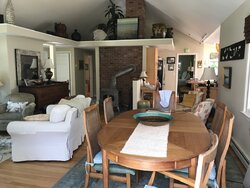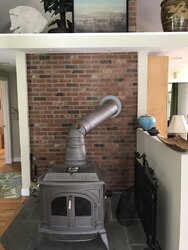i always controlled my stove temperature with lever in back of my Vigilant...will air intake lever on Rangeley work the same way?
switching out VC Vigilant for Jøtul Rangeley
- Thread starter CapeCodder
- Start date
-
Active since 1995, Hearth.com is THE place on the internet for free information and advice about wood stoves, pellet stoves and other energy saving equipment.
We strive to provide opinions, articles, discussions and history related to Hearth Products and in a more general sense, energy issues.
We promote the EFFICIENT, RESPONSIBLE, CLEAN and SAFE use of all fuels, whether renewable or fossil.
You are using an out of date browser. It may not display this or other websites correctly.
You should upgrade or use an alternative browser.
You should upgrade or use an alternative browser.
The burn cycle will be different with the Rangeley or other non-cat stove. The F50 can run on cycles of 2 or 3 loads per day depending on outside temps. We have the same size stove. In above freezing weather the stove typically gets loaded around 8 am and 8 pm. Below freezing we load it 3 times a day at 7am, around 3pm and then at 10pm. One can control the temp and speed of the burn by the size of the wood loaded, the quantity of wood loaded, the species of wood (and dryness) and the flue temp at which the stove is turned down. A flue thermometer and good stove top thermometer help one with regulating the stove and to know when to turn down the air
The F50 and F55 are popular stoves. They run the same way. There are many threads here in the past couple year describing the operation and burn cycles of these stoves. The air is turned down in increments, keeping the flame lazy once the wood has ignited.
Here are a couple threads on running these stoves:
https://www.hearth.com/talk/threads/jotul-f55-tunnel-of-love.164160/
https://www.hearth.com/talk/threads/f55-owners-step-inside.138456/
https://www.hearth.com/talk/threads/anyone-run-a-jøtul-f-55-carrabassett.101184
The F50 and F55 are popular stoves. They run the same way. There are many threads here in the past couple year describing the operation and burn cycles of these stoves. The air is turned down in increments, keeping the flame lazy once the wood has ignited.
Here are a couple threads on running these stoves:
https://www.hearth.com/talk/threads/jotul-f55-tunnel-of-love.164160/
https://www.hearth.com/talk/threads/f55-owners-step-inside.138456/
https://www.hearth.com/talk/threads/anyone-run-a-jøtul-f-55-carrabassett.101184
Last edited:
BG is correct. Recent ( 20 years or so ) EPA non cats cannot shut down like the original VC Vigilant/Defiants. Like he says, for temperate climates in the upper Northeast loading 3+ times a day was common with the Jotul Oslo.
Jotul's EPA non cats can extend burn times by using larger splits at night, higher BTU species like the Oaks, and a kind of hack we did by stuffing steel wool into the primary air intake at the rear. With our now defunct Oslo, it was easy to get overnight burns with that technique in low teens to singles temps outside.
The Vigilant/Defiants were more like Begreens Jotul 602 which can be completely shut down. Those original VC stoves did however have the new at the time secondary air. We're hoping the the present owners of VC have the same sense of build quality, engineering, and service that the guys in Randolph, VT had.
Jotul's EPA non cats can extend burn times by using larger splits at night, higher BTU species like the Oaks, and a kind of hack we did by stuffing steel wool into the primary air intake at the rear. With our now defunct Oslo, it was easy to get overnight burns with that technique in low teens to singles temps outside.
The Vigilant/Defiants were more like Begreens Jotul 602 which can be completely shut down. Those original VC stoves did however have the new at the time secondary air. We're hoping the the present owners of VC have the same sense of build quality, engineering, and service that the guys in Randolph, VT had.

Old stoves used to run on the stoke and smolder at night principal. It worked to have hot coals in the morning, but the heat was poor because the gases were not combusted and the energy not fully used. The process usually resulted in filthy chimneys, risk of chimney fire and created a lot of air pollution. VC stepped in 1977 and started addressing these issues with two technologies, secondary burn and thermostatic operation. The original VC stoves were well made and a wonderful improvement, but although they burned more cleanly, they had complicated systems that required maintenance to keep running well. That often did not happen and after a lot of burning the secondary passages clogged with ash, bypasses didn't seal well, etc. Simpler and much more efficient, clean burning, secondary technology was introduced in the mid-80's and by the 1990s it dominated the market and has continued to, with refinement, to this day. This is what is in the Rangeley.
I love my VC...have used a Vigilant since the mid 70’s...
But I’d like to burn more efficiently...have smaller stove pipe...and something a bit more attractive...
I realize burning the Rangeley is going to be totally different...and it’s just difficult to understand what to do at night...do I just not load it as much? How do I control the heat?
But I’d like to burn more efficiently...have smaller stove pipe...and something a bit more attractive...
I realize burning the Rangeley is going to be totally different...and it’s just difficult to understand what to do at night...do I just not load it as much? How do I control the heat?
As noted, it will depend on outside temps. During cold weather you will be doing full loads at night using larger splits. During mild fall weather you may choose to run a partial load and let the fire burn out. Practice will help. If you read full threads I provided the links to you will find people discussing this. It's a very common question for new stove owners at the beginning of the heating season.I realize burning the Rangeley is going to be totally different...and it’s just difficult to understand what to do at night...do I just not load it as much? How do I control the heat?
Thanks begreen...I read all the threads...hard to believe the burn 50TL 750? I would burn my VC AT 500 in evenings for 10 minutes or so to burn out creosote...but mostly my stove burned at 300-400 stove pipe temperature...
Maybe I should put a damper in so I can cool it down if I get heated out of house or nervous that I can’t control the fire
Maybe I should put a damper in so I can cool it down if I get heated out of house or nervous that I can’t control the fire
It will burn at a steady 650 or even 500. 750º is the top end of safe, but usually not necessary. A lot of people wait too long to start closing down the air. This is because they are going by stove top temperature instead of by flue temperature or even by eye. If one waits too long to start closing down the air the secondary burn gets too intense, wasting a lot of heat up the flue and possibly exceeding the stove pipe spec. I wrote about this last fall and gave some instructions for following flue temp instead of stove top temp.
example thread which is a continuation of diagnosing a potential overfire situation
https://www.hearth.com/talk/threads/newbie-questions-on-temperature.167316/
https://www.hearth.com/talk/threads/newbie-questions-on-temperature.167316/
Most likely not necessary unless the flue system is taller than 30'.I’ve always used flue temps...
What do you think about damper idea?
example thread which is a continuation of diagnosing a potential overfire situation
https://www.hearth.com/talk/threads/newbie-questions-on-temperature.167316/
Most likely not necessary unless the flue system is taller than 30'.
Sure, just upload them to this thread.I’m going to send you a couple pics of my space..is that ok?
This is the space I heat...kitchen over to right..bedrooms in back..
15’ peak ceilings...beautiful but problematic...and loft over woodstove is where the heat goes..I have fan up there..
15’ peak ceilings...beautiful but problematic...and loft over woodstove is where the heat goes..I have fan up there..
Forgot about the Vigilant thermostatic air control, unique by VC at the time. Hate it when Begreen is right.
He mentioned the complexity of the air passages in the stove that was a main reason for efficiency and need for very hot fires to burn off creosote when you used the damper.
That Vigilant looks almost new and cared for.
You will need to think about a SS chimney liner if none there now.

He mentioned the complexity of the air passages in the stove that was a main reason for efficiency and need for very hot fires to burn off creosote when you used the damper.
That Vigilant looks almost new and cared for.
You will need to think about a SS chimney liner if none there now.
Purchased it second hand...it was in bad shape...I sanded and painted it a taupe color..
Replaced gaskets etc...
Thermostat on the back is the best...I close it completely and put something against it at night..always coals in the morning...BUT it sits too far out into the room...has to have big clearances from 1/2 wall...and it’s very old! Maybe 1978?
Anyway I have an opportunity for a new one so I’m going for it...but def want to make the right choice for my space.. I do have lined chimney in my one story home with a hip roof
I
Replaced gaskets etc...
Thermostat on the back is the best...I close it completely and put something against it at night..always coals in the morning...BUT it sits too far out into the room...has to have big clearances from 1/2 wall...and it’s very old! Maybe 1978?
Anyway I have an opportunity for a new one so I’m going for it...but def want to make the right choice for my space.. I do have lined chimney in my one story home with a hip roof
I
No need for pipe damper that I can see. A ceiling fan on the other hand is almost mandatory. The Rangeley is cast iron jacketed. It will be a much more convective (and much less radiant stove) which will help a bit with heat circulation and a more even, softer heat.I think my pipe will go up 2’ then a 90’ then 30” back to chimney...so damper?
Yes, the F50 or F55 should work well and you're going to love the improved fire view.Do you think Rangeley will be a good choice for this space?
Light in the Dark
Feeling the Heat
I have a Rangeley, and its a nice stove. It would be nicer if Jotul jumped into this century with some hybrid tech though... but it heats well, you can cook in it, and its a very simply designed stove so it looks nice in many different rooms.
If I ever save enough up to get a hybrid, Ill be putting my Rangeley in my garage I think so I don't freeze my ass off in the winters anymore.
If I ever save enough up to get a hybrid, Ill be putting my Rangeley in my garage I think so I don't freeze my ass off in the winters anymore.
Similar threads
- Replies
- 6
- Views
- 762
- Replies
- 3
- Views
- 888
- Replies
- 0
- Views
- 408
- Replies
- 9
- Views
- 675
- Replies
- 0
- Views
- 204



